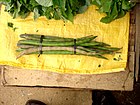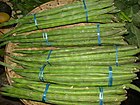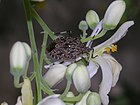Note: This is a project under development. The articles on this wiki are just being initiated and broadly incomplete. You can Help creating new pages.
Difference between revisions of "Moringa oleifera - Drumstick"
(→Photo Gallery) |
(→Commonly seen growing in areas) |
||
| Line 55: | Line 55: | ||
==Commonly seen growing in areas== | ==Commonly seen growing in areas== | ||
| − | {{Commonly seen|Tropical | + | {{Commonly seen|Tropical area}}, {{Commonly seen|Subtropical area}}, {{Commonly seen|Equatorial climate areas}}. |
==Photo Gallery== | ==Photo Gallery== | ||
Revision as of 11:35, 27 March 2019
Moringa oleifera is the most widely cultivated species of the genus Moringa, which is the only genus in the family Moringaceae.
Contents
- 1 Uses
- 2 Parts Used
- 3 Chemical Composition
- 4 Common names
- 5 Properties
- 6 Habit
- 7 Identification
- 8 List of Ayurvedic medicine in which the herb is used
- 9 Where to get the saplings
- 10 Mode of Propagation
- 11 How to plant/cultivate
- 12 Commonly seen growing in areas
- 13 Photo Gallery
- 14 References
- 15 External Links
Uses
Arthritis, Joint pain, Asthma, Cancer, Diabetes, Constipation, Epilepsy, Diarrhea, Stomach pain
Parts Used
Chemical Composition
Investigation of the carotenoid contents from the leaves, flowers and fruits of eight M. oleifera cultivars from India yielded luteoxanthin, lutein, zeaxanthin, and β-carotene[1]
Common names
| Language | Common name |
|---|---|
| Kannada | Nuggekayee |
| Hindi | Sahjan |
| Malayalam | Muringa |
| Tamil | Murungai Maram |
| Telugu | Munagachettu |
| Marathi | NA |
| Gujarathi | NA |
| Punjabi | NA |
| Kashmiri | NA |
| Sanskrit | |
| English | Drumstick |
Properties
Reference: Dravya - Substance, Rasa - Taste, Guna - Qualities, Veerya - Potency, Vipaka - Post-digesion effect, Karma - Pharmacological activity, Prabhava - Therepeutics.
Dravya
Rasa
Tikta (Bitter), Katu (Pungent)
Guna
Laghu (Light), Ruksha (Dry), Tikshna (Sharp)
Veerya
Ushna (Hot)
Vipaka
Katu (Pungent)
Karma
Kapha, Vata
Prabhava
Habit
Identification
Leaf
| Kind | Shape | Feature |
|---|---|---|
| Simple | Tri-pinnate | Leaf Arrangement is Alternate-spiral and Leaf Shape is Ovate or elliptic |
Flower
| Type | Size | Color and composition | Stamen | More information |
|---|---|---|---|---|
| Unisexual | flower borne on a false pedicel 7-15 mm | white to cream | 5 | In axillary, divaricate panicles; white. Flowering throughout the year. |
Fruit
| Type | Size | Mass | Appearance | Seeds | More information |
|---|---|---|---|---|---|
| elongate | torulose capsule, angled, longitudinally 3-valved; seeds many, 3 angled, 3 winged. Fruiting throughout the year | Bark corky grey | many seeds | {{{6}}} |
Other features
List of Ayurvedic medicine in which the herb is used
- Vishatinduka Taila as root juice extract
Where to get the saplings
Mode of Propagation
How to plant/cultivate
Moringa oleifera is believed to be native to sub-Himalayan tracts of northern India but is now found worldwide in the tropics and sub-tropics. It grows best in direct sunlight under 500 meters altitude[3]
Commonly seen growing in areas
Tropical area, Subtropical area, Equatorial climate areas.
Photo Gallery
References
External Links
- Ayurvedic Herbs known to be helpful to treat Arthritis
- Ayurvedic Herbs known to be helpful to treat Joint pain
- Ayurvedic Herbs known to be helpful to treat Asthma
- Ayurvedic Herbs known to be helpful to treat Cancer
- Ayurvedic Herbs known to be helpful to treat Diabetes
- Ayurvedic Herbs known to be helpful to treat Constipation
- Ayurvedic Herbs known to be helpful to treat Epilepsy
- Ayurvedic Herbs known to be helpful to treat Diarrhea
- Ayurvedic Herbs known to be helpful to treat Stomach pain
- Herbs with Leaves used in medicine
- Herbs with Flowers used in medicine
- Herbs with Pods used in medicine
- Herbs with Seeds used in medicine
- Herbs with common name in Kannada
- Herbs with common name in Hindi
- Herbs with common name in Malayalam
- Herbs with common name in Tamil
- Herbs with common name in Telugu
- Herbs with common name in English
- Habit - Small tree
- Index of Plants which can be propagated by Seeds
- Index of Plants which can be propagated by Cuttings
- Herbs that are commonly seen in the region of Tropical area
- Herbs that are commonly seen in the region of Subtropical area
- Herbs that are commonly seen in the region of Equatorial climate areas
- Herbs





